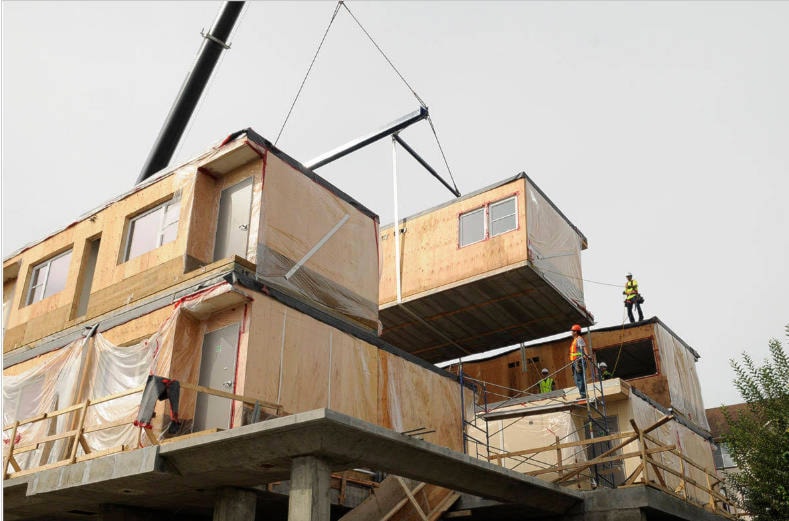Houston needs a wide range of housing options for current residents of all ages and incomes and to attract newcomers, a multi-page study prepared for the District of Houston reveals.
Prepared by the University of Northern British Columbia’s Community Development Institute under a $25,000 contract let by the District, the study identifies five key housing needs —emergency housing, subsidized housing, supportive housing, rentals and expanded home ownership options.
The study confirms several key areas brought up by the District of Houston council in recent years, including more housing for elderly residents.
And it speaks to representations and concerns made by residents to the District regarding the current declining state of some existing housing stock within the community.
The study also affirms the plan by the District to increase its ability to enforce building maintenance standards by passing a new bylaw and by the hiring of a bylaw enforcement officer who will work for the District half time and for the Regional District of Bulkley-Nechako half time.
It recommends the District develop a close relationship with the provincial BC Housing agency for social housing and with the Northern Health Authority for supportive and complex care housing for seniors and others.
It also recommends an expanded effort to educate the public on property management, tenant rights and property maintenance, the latter being a key consideration behind the District’s new standard of maintenance bylaw.
Crucially, the study identified four areas affecting local housing — the temporary demand for housing spurred by the construction of the Coastal GasLink natural gas pipeline, uncertainty within the forest sector and what that means for demands for new housing, the closure of Super Valu in 2016, although Buy-Low opened a year later and the influence on the community of housing shortages and conditions in nearby communities.
“People spoke about residents who moved from Smithers or the Lower Mainland where rising housing prices and rental costs prompted migration. Housing needs in indigenous communities have further prompted people to look at housing options in Houston,” the study noted.
Here’s a summary of the five key housing needs:
Emergency housing
There’s no homeless shelter, safe house or transition house with the closest transition homes being located in Smithers and Burns Lake. Often local agencies place people in local motels.
Subsidized housing
There’s no subsidized housing for single low income residents under 55 or for low income families.
“Despite a substantial indigenous population, there is no subsidized indigenous housing in Houston,” the study notes.
The lack of subsidized indigenous housing, however, could be addressed provided the Dze L’Kant Friendship Centre is successful in an application to a provincial program to construct a complex complete with a childcare space.
For its part, the District of Houston is to negotiate a long term lease with the friendship centre to provide a now-vacant lot for a housing complex.
Supportive housing
There’s limited housing for seniors, a lack of assisted living spaces and a lack of complex care housing for seniors and others.
“A lack of assisted living and complex care units means that residents must relocate away from Houston and from family and social networks,” the study emphasized.
This lack has also been raised by the District of Houston council, particularly as the local population ages.
Market rentals
Based on research and interviews with local residents, the lack of quality rentals, lack of furnished apartments, lack of rentals for large families, lack of duplexes and general lack of homes to rent were highlighted.
“Market rentals that are affordable for low-income residents are generally regarded as in the poorest condition,” the study stated.
A lengthy list of deficiencies was provided, including structural issues, electrical issues, aging plumbing, leaking roof and toilets, mould and asbestos, poor insulation, inefficient heating, pests and inadequate windows and locks.
Home ownership
A lack of new homes to purchase and a lack of small homes surfaced as issues raised through the study.
“With an aging housing stock, there is a lack of new housing to attract and retain professionals and support home ownership,” the study revealed.
“Fewer smaller homes have been developed to enable older residents to downsize or to support home ownership options for individuals or couples with no children.”
“More investments in high-quality single detached housing are needed to attract new families to the community. This includes, in the case of renovation, investments in modern finishes and updated carpets, countertops, cupboards, light fixtures, and bathroom amenities, as well as high quality finishes such as new siding, roof shingles, doors, windows and resurfaced driveways,” the study noted.
“As families acquire more financial assets, there is also an interest in larger acreage properties to support a rural and outdoor-based lifestyle.”
In speaking with local residents, the study authors did note that the cost of purchasing a home in Houston was more affordable than in other parts of the province.
“The closure of Houston Forest Products [in 2014] was credited with improving the affordability of home ownership for former renters,” the study said.
